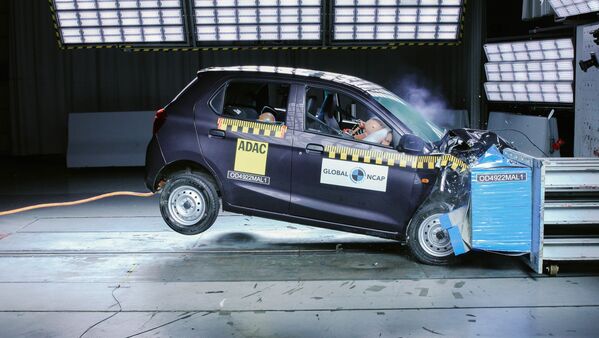In the past nine years, NCAP has tested 62 cars in India. Half of them scored less than 3 stars for adult safety. That is a horrible track record and in most countries around the world—including some developing nations like Brazil – such cars would not be allowed on the roads. Adding to the bad news, 20 of the 62 cars scored zero.
In the latest round of tests, two mid-size sedans — Skoda Slavia and Volkswagen Virtus – scored full 5 stars for safety but the two entry-level small cars — Alto K10 and WagonR – embarrassed themselves. The K10 – one of the cheapest cars on the market and the fourth-largest selling car in the country – scored only 2 stars for safety. The WagonR, India’s largest-selling car for two years now, scored only 1.
A couple of disclaimers are required before we dig deeper. Cars and the crash tests have both evolved over the years, so it isn’t fair to compare the results of cars from different years. The initial lot of cars, for example, came without airbags. These were followed by cars with a single airbag, and now most cars have at least two. Airbags have a big bearing on the results of crash tests. At the same time, Global NCAP upgraded the test last year to include side-impact tests and side impact with a pole. To achieve a 5-star rating now, vehicles need additional safety features like electronic stability control and pedestrian protection systems, among others.
With a few notable exceptions, there is a clear pattern of how cars fare in crash tests in India — the smaller, cheaper cars perform significantly worse than more expensive ones. The likes of Alto, WagonR, Swift, i10, SPresso and Ignis have flunked the test on various occasions. Even in today’s stricter safety regime, these cars have not improved their ranking. The Swift for example, has been tested thrice and has always scored less than 3 stars.
Cars in India are designed for consumers that do not have a lot of money to spend — India ranks 127th in the world on GDP per capita. The average price of a car in India – $8,000 – is among the lowest in the world. The Tata Nano was the flagbearer of this kind of no-frills engineering not long ago. But bear in mind that low costs are despite higher taxes — between 29-50% – than in most countries around the world.
Historically, lax safety and emission norms allowed companies to bridge this gap between high taxes and low affordability by offering cheaper products that were a few generations behind those in the developed world. In recent times, India has caught up with the world on emissions but safety remains an area of neglect.
Just how lax are we? In the Global NCAP’s tests, cars are driven at 64 kph with 40% overlap into a deformable barrier. Currently, India conducts front offset tests at a lower speed – 56 kph. An 8 kph gap may not appear much but it makes a world of difference in an accident and a vehicle may need to be overhauled entirely to comply with it.
One way to comply is by adding more safety features but these cost money and manufacturers, constrained by low affordability and high taxes, have always resisted this. Market leader Maruti Suzuki, for example, is lobbying aggressively against a proposal to make six airbags mandatory. Such a regulation would make cars safer but would come at a cost. Apart from the increased cost of making such cars, some existing models would not be able to comply and would have to be scrapped entirely.
Yet, the cost argument does not always hold true. The cost of fitting two airbags has come down significantly from close to ₹1 lakh a decade ago to less than ₹20,000 thanks to economies of scale. The bigger issue is of the structural bodyshell integrity of a car. In layman’s terms this measures the ability of a car to withstand impacts. If the structure is unstable, the addition of safety features such as airbags and traction control do not have the desired effect. The WagonR for example, got one star less than the AltoK10, perhaps because it has an unstable bodyshell.
A host of other cars that fared poorly such in 2022, as the Swift, S Presso, Ignis, i20, Creta, and Renault Triber, had at least two airbags and represented a cross-section of price points. But they all had an unstable bodyshell that made them unsafe. The Kia Carens in fact has six airbags but also an unstable bodyshell.
Fortunately, there are some positives, too. Besides European carmakers, the two manufacturers that have made the biggest strides on safety in recent times are Tata and Mahindra. The two firms account for six of the 8eight cars that have received 5 star ratings in the country so far. These include mass-market models such as Tata Punch, Nexon, Altroz and Mahindra XUV3OO.
Yet, India still has a number of cars across segments and price points that have poor structural integrity. They are deemed fit to ply on the roads as our regulations are lax. Many of them are bestsellers, too. While Tata and Mahindra have gained market share on the back of their results in crash tests, others with poor results still find enough takers.
In the minds of the budget-oriented consumer, safety often takes a back seat, and this mindset needs to be weeded out. The upcoming Bharat NCAP test regime is likely to do that job.
Download The Mint News App to get Daily Market Updates.
More
Less
#Mint #Explainer #Indias #popular #cars #perform #poorly #crash #tests
